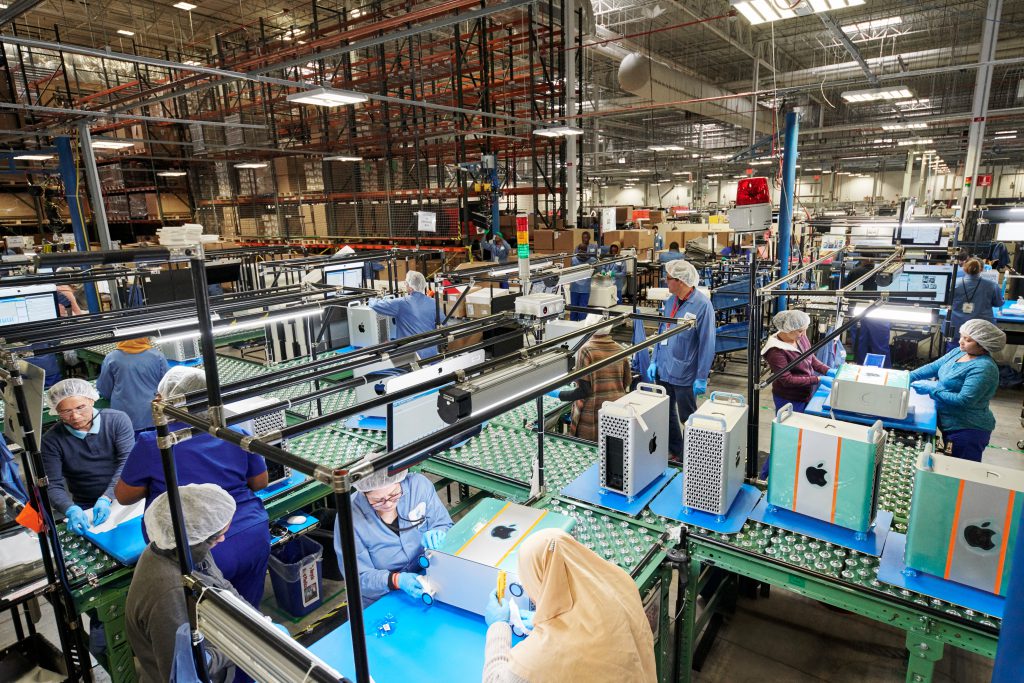
President Trump seems happy, but let’s be honest: A lot of this is just P.R.
Designed in California, Made in Texas.
Well, this one thing sort of is, anyway.
One of the more interesting case studies in the ongoing U.S.-China trade conflict has been Apple. The company is an iconic American brand, but nearly all of its products are put together in China, including at facilities that have been accused of serious environmental and labor violations.
That has put the company in the crosshairs of President Trump, who has frequently lamented that the iPhone is not Made in America. But while some companies go into fighting mode after similar Trump attacks, Apple isn’t taking it personally. CEO Tim Cook has frequently dined with Trump, perhaps betting that his company will be better served by playing nice with the White House.
Apple has been walking a fine line.
Although the company publicly opposes the Trump administration’s China tariffs – Apple is very dependent on China – it also has played up its manufacturing activity in the United States in recent years.
In 2018, the company pledged to contribute $350 billion to the U.S. economy between 2018 and 2023. It also claims to source from 9,000 suppliers and support 2.4 million jobs in the U.S., including 450,000 manufacturing and operations jobs. It also says it will spend $5 billion on advanced manufacturing, and already has announced some successes.
At one point, Cook even argued that the iPhone is Made in America because some of its parts are sourced stateside.
But there’s more to the story.
Apple’s iPhones are not Made in America. They’re actually assembled at dangerous places like this and the bulk of Apple production still happens abroad. While Apple talks a good game about American manufacturing, it always puts its bottom line first – and maintaining that bottom line means making the iPhone and iPad and nearly everything else it sells overseas.
Except, that is, for the Mac Pro.
The Mac Pro is Apple’s most powerful computer, used by professionals who need a computer to do much more than check email and post to Facebook. All that power comes with a big price tag; the cost of the newest edition starts at $5,999.
Apple has assembled the Mac Pro in Austin since 2013, and Cook himself has called it “a point of pride” for the company. But in June, Apple announced that it would shift production of the Mac Pro from its facility in Texas to China.
Although Apple argued that such a shift had long been in the works, many analysts cited Trump’s China tariffs as the reason for its decision.
And Trump took it personally. The president even made a point to tweet that he wouldn’t give Apple tariff waivers to assemble the computer in Texas.
But then in September, Apple reversed course, saying it would keep production in the Lone Star State… after the Trump administration exempted some key products from tariffs. Huh.
Anyway, the latest chapter in this saga took place in Austin on Wednesday, when Apple broke ground on a new campus and officially kicked off production of the newest edition of the Mac Pro. Trump even flew down to Texas for the big event, generating all sorts of excitement!
Apple is really making a big deal out of the facility, noting that the Mac Pro plant employs more than 500 people who help assemble the high-tech machines. Trump also seemed happy, and not just because it provided a distraction from, um, ongoing events in D.C.
https://t.co/ytr7dRvbUc pic.twitter.com/G6lGfyxSUs
— Donald J. Trump (@realDonaldTrump) November 21, 2019
Look, we applaud Apple for maintaining production of the Mac Pro in Texas. We also support the company’s decision to source parts for some of its other products from the United States. But unfortunately, it appears that its actions here are less about American manufacturing and more about public relations.
Apple is still extremely reliant on China, not just for the physical production of its products but also for supply chains. 9to5mac pointed out that even with the Mac Pro, “most of the components are made in China, with final assembly in the US.”
In many ways, Apple is just taking advantage of the system it operates in. As AAM President Scott Paul told The Washington Post in September, tax incentives still encourage companies to shift manufacturing overseas. Lax labor and environmental laws also keep costs low. “Over the longer term we’re going to need much broader policy shifts to keep American high tech manufacturing jobs here,” he said.
Obviously, Team AAM is on board with any policy shifts that encourage American manufacturing. It’s what we do here, and we are going to keep working for it.
But Apple is one of the world’s most powerful companies, and it can play a major role in changing the game. Instead of depending on exploitative labor practices at facilities overseas and working hard to get tariff exemptions, the company should focus on implementing a serious plan that shifts more production stateside.
Actually making the iPhone in the United States seems like a good start, by the way. Doing so would only increase the cost of the phone by $30 to $40 – and how great would an actual “Made in America” label look on those things?
